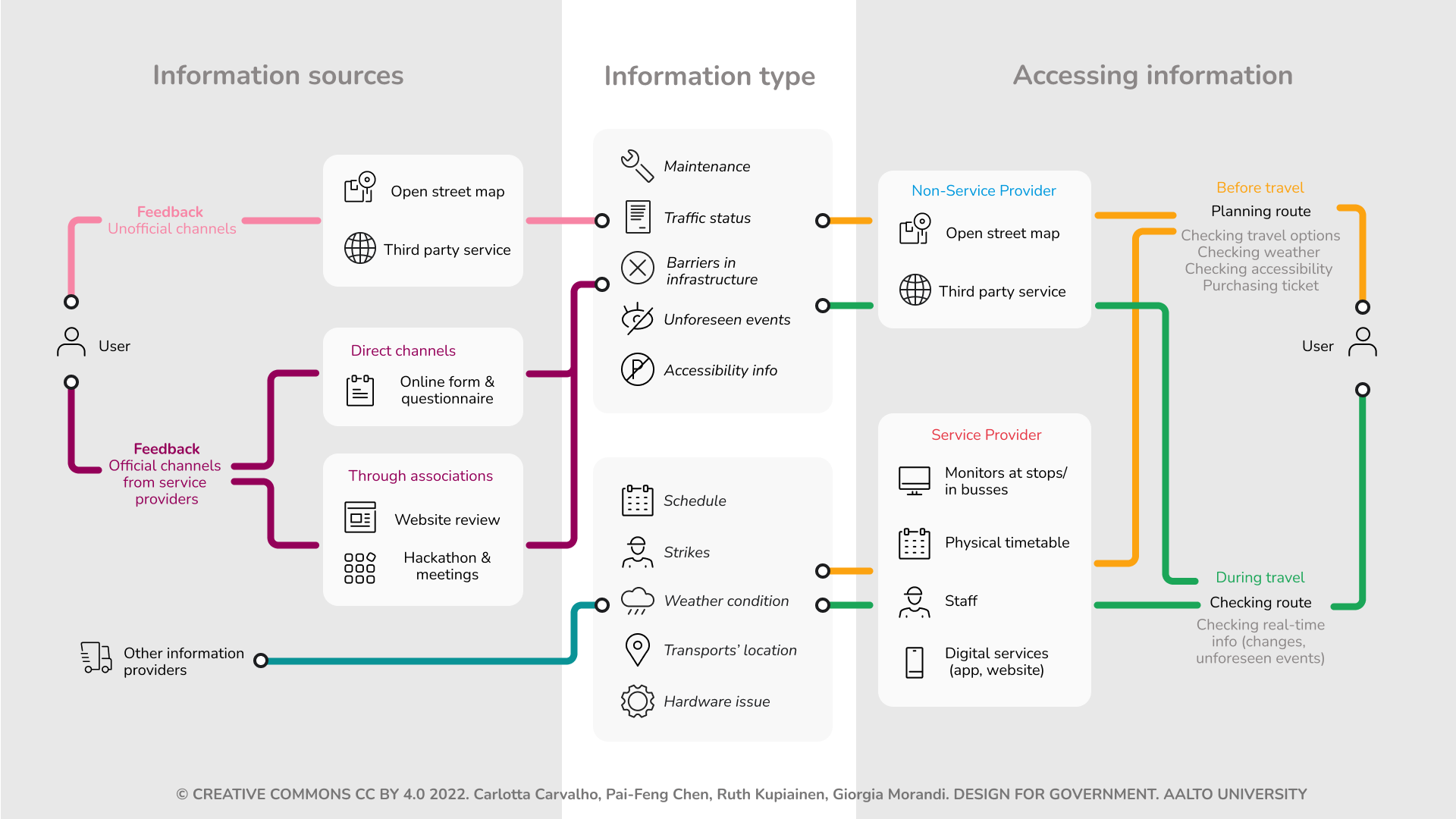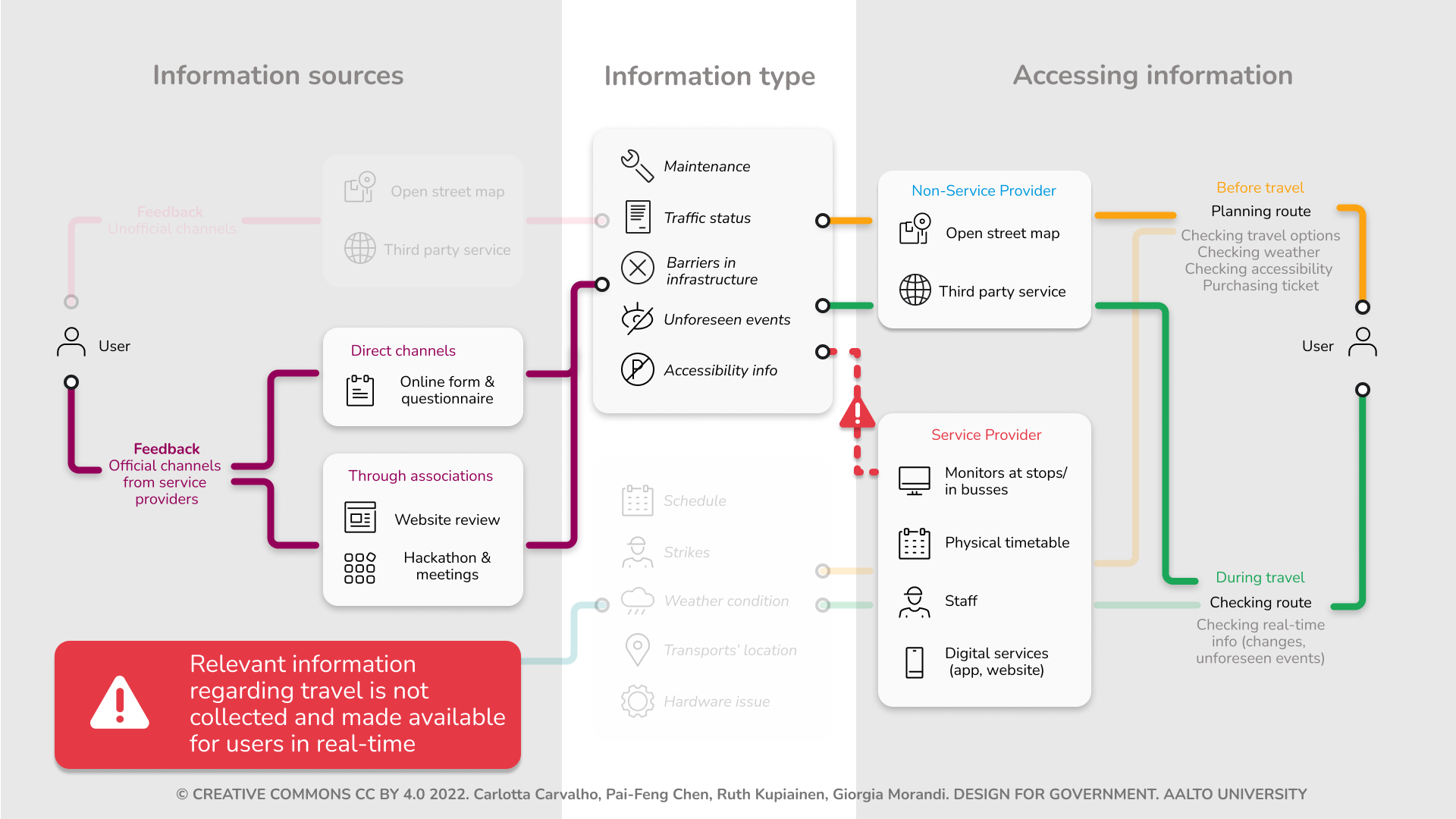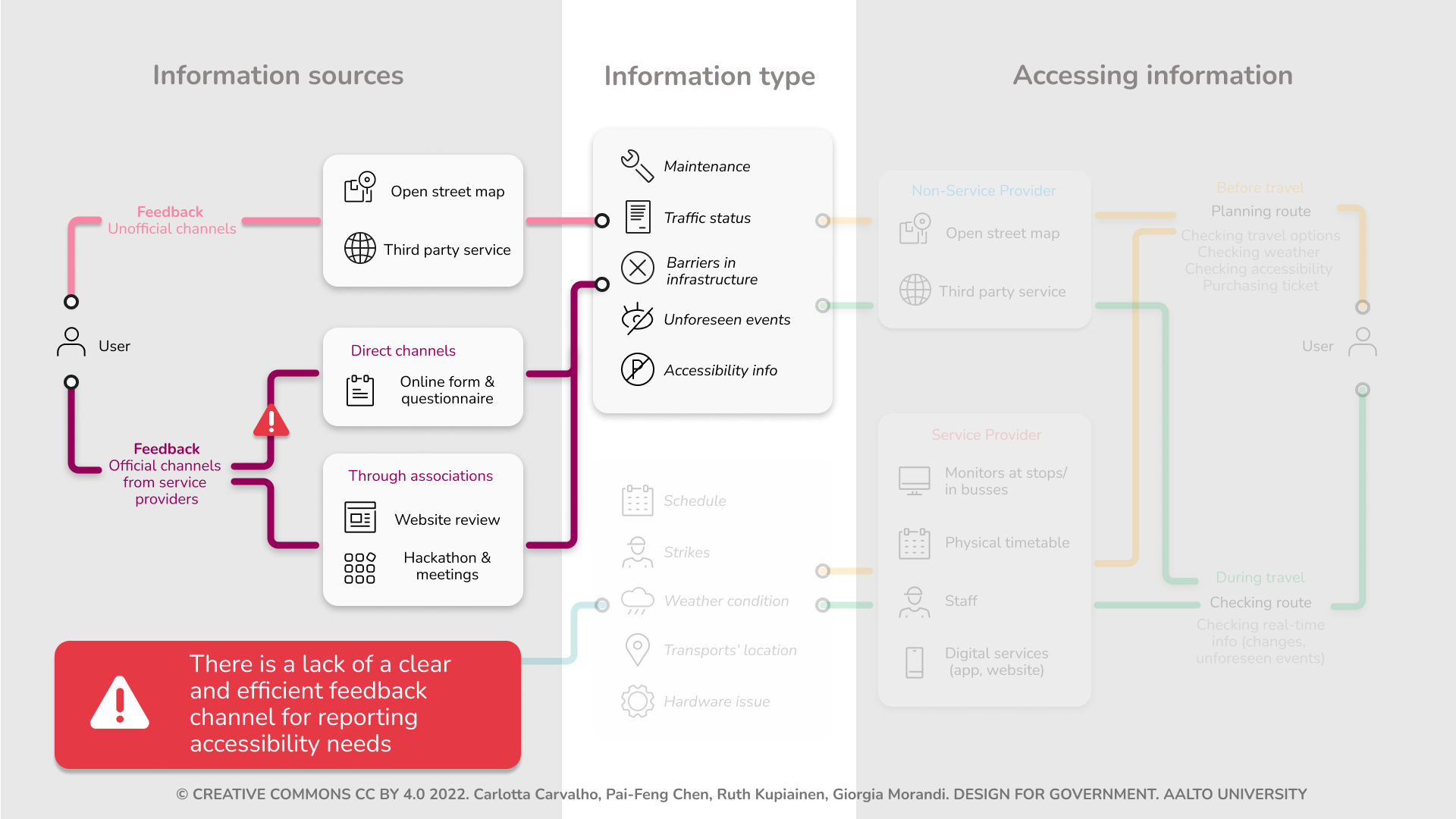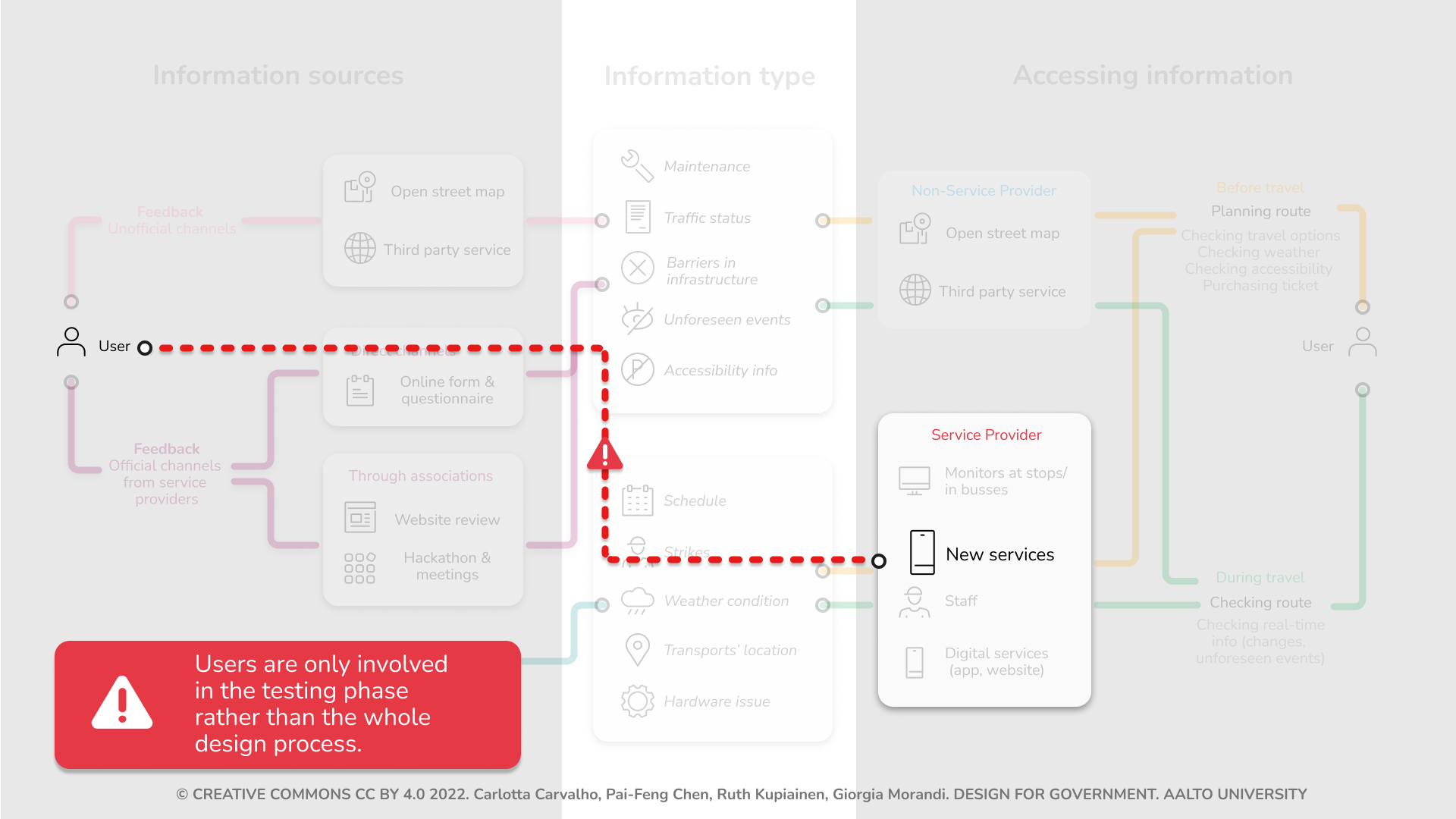This blog post reports on work-in-progress within the DfG course! The post is written by group 2B dealing with the Ministry of Transport and Communications’ brief on Accessible Traffic Chains. The group includes Carlotta Carvalho from Collaborative and Industrial Design program, Giorgia Morandi from the Creative Sustainability program, Pai-Feng Chen from Collaborative and Industrial Design program, and Ruth Kupiainen from International Design Business Management program.
Written by: Giorgia Morandi
Borrowing the metaphor of the iceberg model (Meadows, 2008), the problem with the accessibility of public transport is only what we see, the tip of the iceberg. In recent weeks, we have tried to go deeper, investigating the underlying dynamics of the Finnish transport system.
Despite everyone wanting the same thing – greater accessibility – current individual efforts are not having the impact needed to change the whole system. But why does it happen? Where are the critical gaps that prevent the system from being “accessible from all the users’ perspectives”? (T. Saarinen – Traficom, Roundtable discussion, March 8) To answer these questions, we adopted a systemic approach, mapping the connections between different actors and analysing the dynamics at play.
Since our last post, given the complexity of the brief, we wisely decided to continue our research together with groups 2A and 2C to use our time efficiently and collect a larger amount of information. As the research evolved, our group gradually decided to focus on an important part of public transport accessibility, namely the communication between users and service providers. In the final weeks of the research, we, therefore, focused our efforts on understanding how information travels within the system and, in particular, how it reaches the end user.
Along the way, we used methods such as benchmarking to compare best practices internationally, while interviews and mapping of the transport system helped us delve deep into the system dynamics. In the end, we synthesised and finalised the research into a series of valuable insights that we believe hold the potential for change.
Why talk about an information system?
Our first research question aimed to learn about the visions and current actions of service providers in building an accessible transport chain. One of the first critical points that emerged in the roundtable discussion, which was later confirmed by the interviews, was the accessibility of information.
By information we mean, in this case, all the data that the user should be able to access in order to travel easily and without impediments. This necessity also appears to be cross-cutting in all the accessibility groups and to the needs of each user. Indeed, this topic was discussed a lot during our roundtable session. For example, Janne Lautanala from Fintraffic mentioned that “The problem, is that even for non-disabled it’s extremely difficult to even find the way, not to mention the kind of accessible way. (…) it’s very difficult. Then there’s the slush and snow, and it makes it even worse. The data is not static. It’s very dynamic.”
Whether one has any physical limitations, suitcases, pushchairs or simply the need to get from point A to point B smoothly, one must be able to plan their journey according to their needs and be sure of reaching their destination safely. This information is not only about planning but also about real-time communication of any changes or unforeseen events in the planned route. Since the roundtable, it has become clear to us that providing accessible information is essential to achieve the goal of an accessible travel chain.
In addition, the information system is part of the broader transport system and is a key pillar of it, which currently distinguishes public transport from individual transport. From our perspective, making public services accessible to encourage sustainable mobility also means ensuring that communication is reliable and efficient, so that public transport can begin to compete with the ‘simplicity’ of using individual means of transport.
“Real-time, up-to-date, accurate information found on the internet is essential, otherwise trips may not be made. People get discouraged and don’t go.”
– Sanna Kalmari, accessible travel expert and travel blogger
Translating research into insights
Considering the importance of the information context in our brief, we gradually oriented our research and looked at the problem of accessibility from this angle. In the last phase of our exploratory journey, we asked ourselves how information is currently collected and how it is then communicated to end users.

Figure 1 Information flows roadmap
Our next step was to visualise and summarise our findings, and we did this by mapping the information flows (Figure 1). We started by placing the information that is relevant to the user’s journey in the middle, and then we traced how it is gathered (on the left) and when and through what channels the user seeks it (on the right).
From here, we highlighted certain gaps in the system that cause blockages in the information journey to the user, which led to the insights I will share below:
1. Poor communication of real-time information (Figure 2): relevant information regarding travel (such as accidents, malfunctions, temporary inaccessibility of stops, or means with full capacity) is not collected and made available for users in real time. This undermines the reliability of means of transport and makes it difficult to plan one’s journey in advance.

Figure 2 Information flows roadmap (first gap)
2. Lack of a feedback channel for accessibility (Figure 3): Each service provider has different feedback channels, but the user struggles in finding the right platforms to communicate accessibility needs.

Figure 3 Information flows roadmap (second gap)
3. Uneven user involvement (Figure 4): When planning new solutions, service providers involve users through associations, but only at later stages of the process. Moreover, the users involved are not sufficiently representative of all the needs of the population.

Figure 4 Information flows roadmap (third gap)
Could the user be the key?
While delving into the dynamics of the transport system, we have become increasingly aware of the importance of users’ role. From being simple ‘public service consumers’ for whom to design accessible solutions, we think the time has come to consider them as active participants with unique information and knowledge. In our view, involving users throughout the entire design process is crucial to creating accessible solutions and ensuring that their, or rather our, needs are put at the forefront.
Something else from the research that stayed on my mind is that the user is not only the one who needs information, but also the one who can provide it, for example via user feedback. Therefore, the question that now arises is: could users themselves be the solution to their needs and the source of the information they want?
At this point, we can say that we are proud of the path we have taken and curious to see how these ideas will further develop in the second part of the course. We look forward to entering the development phase of possible solutions starting after the Easter break!
Stay tuned!
References:
Meadows D. H. (2008). Thinking in systems
The DfG course runs for 14 weeks each spring – the 2023 course has now started and runs from 27 Feb to 31 May. It’s an advanced studio course in which students work in multidisciplinary teams to address project briefs commissioned by governmental ministries in Finland. The course proceeds through the spring as a series of teaching modules in which various research and design methods are applied to address the project briefs. Blog posts are written by student groups, in which they share news, experiences and insights from within the course activities and their project development. More information here about the DfG 2023 project briefs.

